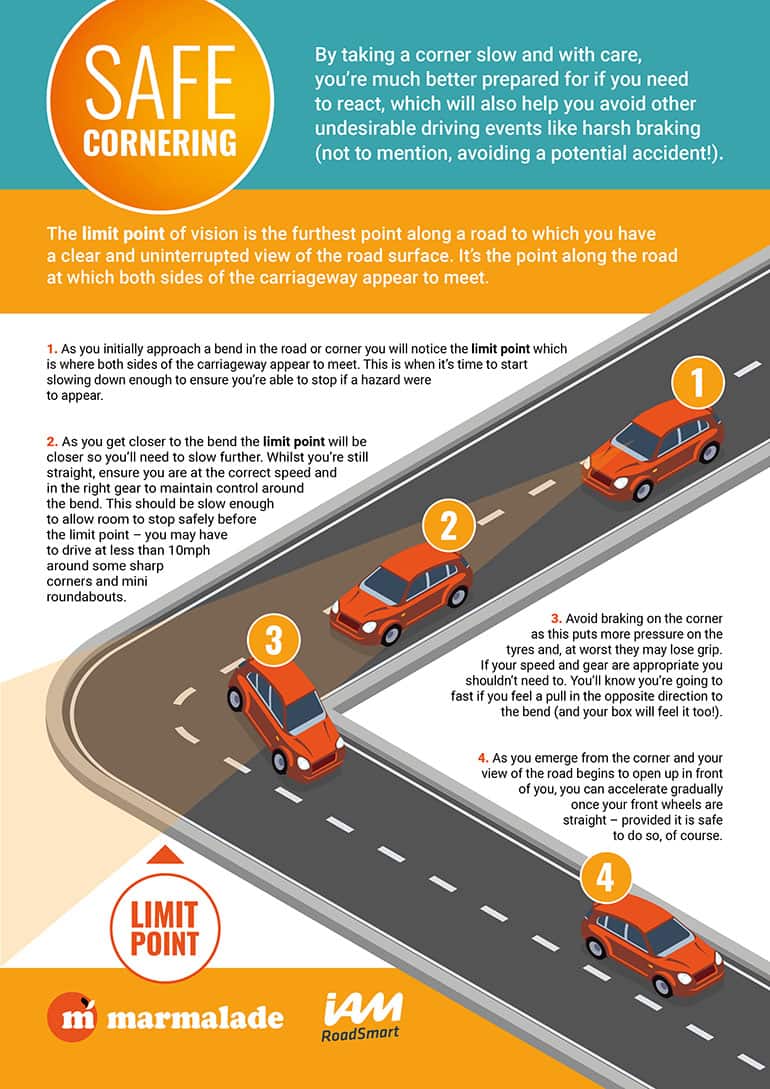For our young drivers, cornering is one of the most common issues flagged, so we’ve created a guide to help you avoid cornering events and aim for a super smooth drive. Our safest drivers can earn an extra safe driving discount on their renewal price!
You’ll be pleased to hear that 96% of our customers’ journeys are classed as green (good) – so we’re not looking for perfect every time. We hope our guide will help you develop your driving skills and earn the best discount you can at renewal.
How do we measure cornering?
You may be wondering how we measure cornering. We promise it isn’t a mysterious art. Essentially your device is measuring the g-force. So, if you feel that gravity is pulling you in the opposite direction to the way you are turning, the chances are you’re taking the corner too fast. Your box will be feeling the same pull and this may trigger a cornering event.
Remember: your device won’t be able to see what driving conditions are like, so it’s set to start triggering a cornering event at the time you would start to lose grip in poor conditions (like rain or ice), so it’s worth bearing this in mind.
Why is cornering safely important?
There aren’t many long, straight stretches of road in the UK – instead we are blessed with a selection of winding country roads, thousands of roundabouts, densely populated towns and residential areas. Driving round a curve or bend is one of our main driving activities!
If you take a corner too fast, the car loses stability and places extra demands on the tyre grip available. The faster you go and the tighter the bend the greater these demands are, and the more likely it is that your tyres will lose grip. If you then add in poor road or weather conditions, you could lose control much earlier than you would in ideal conditions. Not only this, but with a limited view of the road ahead, you may not be able to stop in time if a hazard were around the corner.
Almost half of all fatal collisions for drivers under 30 are the result of a driver losing control on a bend or curve – so developing good habits early really could save your life*.
Tips for cornering safely AKA how to avoid harsh cornering events
The most common cornering events we see are on roundabouts and on rural roads, but we drive round corners every day so these tips will help you at every turn – from sweeping into a drive or parking space to navigating around rural roads.

Tip 1 – take it slow
We sometimes get comments like “I was only driving around the roundabout at 15 or 20mph”. There’s no magic speed to take a corner, and sometimes you’ll need to take corners at a walking pace (if they’re very tight or the weather conditions are poor).
- Essentially, you need to take the corner at a safe speed, and in the right gear, where you feel in control and that your tyres are gripping the road.
- If you’re feeling a slight (or heavy) pull in the opposite direction the way you are turning – or worse still, your passenger is hanging-on to keep steady, it’s likely you’re going too fast.
- It’s dangerous to brake on a corner, as it puts yet more pressure on the tyres, so you really need to enter the corner at a slower speed to avoid having to brake.
- Taking the corner slow will also help you avoid getting flagged for hard braking too (win/win!)
Tip 2 – look ahead and expect the unexpected
As you approach a corner or turn, you need to be confident that you would have time to react if there was a surprise around the bend.
- Ask yourself – would you be able to stop if a bin lorry, or herd of sheep were laying in wait on your side of the road around the corner?
- When you are coming up to a bend, there will be a limit point to your vision if the road is clear. The limit point is the furthest point along a road to which you have a clear and uninterrupted view of the road.
- The limit point will appear closer as you approach the corner. The trick is to make sure you're going slow enough to safely stop before that point – and to avoid having to brake on the corner itself.
- Naturally, if there is a vehicle in front of you, you will need to ensure you're driving at a safe speed and distance behind them (in case they encounter the unexpected!)
Tip 3 – Don’t be complacent
We often see cornering events happen on familiar journeys – and we guess this makes sense. Often, if we are driving somewhere unfamiliar, we are much more cautious and drive slower. However, when we’re used to making the same journey regularly, it’s easy to go on autopilot as you feel more confident if the conditions are generally good – not to mention the fact that with familiar journeys we may leave less time (hands up if you've snoozed your alarm just one more time, when you know you can make it into work in 15 mins!).
- Make sure you leave more than enough time to comfortably reach your destination and keep your full concentration on the road and what’s ahead.
- As a trick to try and avoid being on autopilot in your head, imagine you have a nearly full cup of coffee in your cup holder and challenge yourself to not spill a drop of your imaginary drink enroute!
Tip 4 – Review your journeys
We’re all human and we all make mistakes. It’s unlikely you’ll avoid cornering events altogether. But, by regularly checking your journeys, you’ll see when and where you’ve had events.
- You’ll spot if you’re getting a cornering event on a particular road every time, or if you have an issue with certain areas, like roundabouts.
- The fact is, you’re going to take a corner slightly too fast at some point, and you’ll probably know it when you do it. By reviewing your journeys regularly, you can simply identify where you need to learn from mistakes and move on!
- To keep you motivated you can earn streaks and badges on our app for driving super smooth without cornering events!
Did you know – 96% of journeys driven by our young drivers are green (which is good), and less than 2% are classed as unsafe (red). So, there’s a good chance that when you have the odd cornering event, you’re still likely to have made a good journey overall. We don’t want you to get anxious about small events – they are there to learn from.
Will I be penalised for cornering?
If you are cornering excessively, or have other events flagged, like harsh braking, it may flag a red journey, which we class as unsafe. If this is the case, we will get in touch and chat through the journey with you to help you avoid more red journeys. It’s rare, but repeated unsafe driving could lead to a premium increase. Read about our driver improvement process here.







